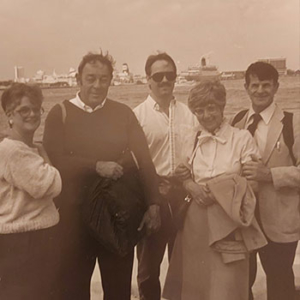 A few years back, I performed our National Anthem as part of a brass ensemble. The Star Spangled Banner was being played at the start of a golf tournament.
A few years back, I performed our National Anthem as part of a brass ensemble. The Star Spangled Banner was being played at the start of a golf tournament.
The tournament was held within a 55-plus community. Upon entering the community, I had to stop at a security shed, present identification, and be issued a pass to drive on the property. The community is quiet, with very little traffic, nice landscaping, and even rolling hills. I thought to myself, what a great place for kids to ride bikes. Even though it was Saturday, there were no children to be seen. It dawned on me that kids don’t reside in a 55-plus community.
I was only in the area for about an hour. Everyone I met was certainly friendly, yet, it didn’t feel like a neighborhood to me. I realized what was missing was a generationally diverse group.
 A few days later, quite by chance, I heard the term “Generational Segregation.”
A few days later, quite by chance, I heard the term “Generational Segregation.”
What? Not another outrage of the week. Nope, this is a real thing. The book 30 Lessons for Living: Tried and True Advice from the Wisest Americans By author Karl Pillemer points out that over 1/3 of people under 30 communicate with someone over 65. However, when relatives are excluded, that number drops to about 5%. Pillemer predicts that we may become the most generationally segregated society ever.
Who Cares? You should. My mother had a plate that hung on the wall of our house that read, “we get too soon oldt undt too late schmart .”(Boy, ain’t that the truth.) Generation integration isn’t just about younger people learning and benefiting from older ones. It goes both ways. When zoning laws, HOA rules, etc., separate people by age, we create this generational segregation. Every generation has experiences that relate to them. The sharing of these experiences across generations can be of great value.
My favorite holiday is Thanksgiving.
My mother was an administrator at an assisted living facility that was run by the local County government. Many of the residents there did not have relatives come to visit. My father and I would pick up a number of those folks and bring them to the house to share our Thanksgiving. The people that resided in that facility could not afford a private pay place to live, and many had seen some difficult times. I admired how they persevered. The stories that went around the table at those times were priceless. It was like a living history lesson. What those folks seemed most excited about was interacting with younger generations. When I would stop in to see my mother at her place of work, I would see the people who had visited us and addressed them by first name at their insistence, of course.
 I have been a financial advisor for more than 35 years and still learn from conversations with clients both older and younger than me.
I have been a financial advisor for more than 35 years and still learn from conversations with clients both older and younger than me.
I see the value in their generational perspectives. We are subtly (or not so subtly) generationally divided by rules, politics, media, and our own ignorance. Don’t get sucked into misconceptions by the sound bite of the day. Take time to interact face-to-face with multiple generations. We might all learn a thing or two.
There is no one size fits all perfect allocation of generational diversification, i.e., 10% millennial, 15% Gen X, 30% Baby boomer … What matters is a general diversification and a willingness to empathize.
Just as there is value in diversifying our financial portfolio, there is value in diversifying the people in our lives.
Pictured in image 1 left to right: Helen (Mom) Bill Sr. (Dad), me, Doris Dunkley (Aunt), Tom Dunkley (Uncle) AKA father of Vermont Gymnastics
Pictured in image 2: John James Slover (Great Great Grandfather), Jacob Henry Slover (Great Grandfather), Percey Jansen Slover (Grandfather)
January 2023
